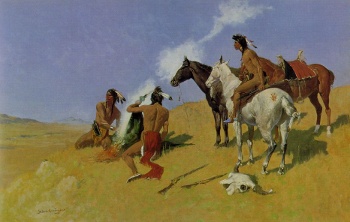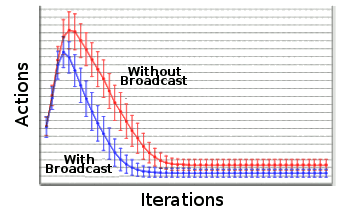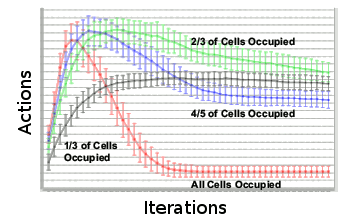Modeling Cultural Evolution
November 13, 2013
Human culture has been affected by the
evolution of
communication technologies over the course of the last
century and a half, from the
electric telegraph and the
telephone (
19th century), through
radio (late 19th century, early
20th century), the
Internet (late 20th century), and
mobile communications devices (late 20th century, early
21st century). This rapid communication has resulted in a convergence of human culture. Most people have adopted a
"Western" lifestyle, although significant backflow events, such as
Gangnam Style, have appeared.

One non-electrical communications method, as employed by Native Americans.
Smoke Signals (1905), oil on canvas by Frederic Remington (1861-1909).
(Via Wikimedia Commons.)
As I wrote in a
previous article (Stone-Age Internet, October 27, 2011),
cultural diffusion was very slow for
Stone Age man, since communication of ideas was mostly by demonstration, and physical contact between individuals was necessary to convey information. A low
population density prevented a rapid information flow throughout the human populace, so everyone was
reinventing the wheel.[1]
Computer modeling of
cultural evolution is a simple
programming task, since it's just a matter of communication between
nodes in a
two-dimensional space. The nodes, of course, are people, and they change their internal state according to what they "hear" from surrounding nodes.
One successful
network model is
percolation theory, which is useful for modeling things such as overall
electrical conductivity of a
composite material. A feature of the percolation model is a sharp
phase transition at a
critical density between two states (e.g.,
insulator-
conductor). One such a percolation model for information diffusion in the Stone Age divided the world into a
checkerboard in which the cells were about a day's walk apart.[2] These cells were populated at selected
densities by campsites of small human groups. Any information that might leave a campsite had a
lifetime, so information did not diffuse too far.
In a standard percolation model, only 0.593 of the cells need to be filled to allow connection from one corner to another, but this Stone Age information diffusion model demonstrated that
civilization could only blossom at a much higher population density.[2]
For two
decades,
Liane Gabora, of the
Department of Psychology, the
University of British Columbia, has been modeling cultural evolution. Her first approach, published in 1994, has been updated as the computer program, EVOC (for
EVOlution of
Culture).[3] EVOC uses a
JAVA open-source neural network library and the open-source
graphical user interface,
JFreeChart.[3] The 1994 program, Meme and Variations (MAV), used a
genetic algorithm to solve for a cultural solution under a set of
constraints.[4-5]
The EVOC neural network is comprised of agents that "
invent" ideas for actions, but also imitate their neighbors' actions. As the model runs through
iterations, the invention phase predominates, since no best actions have been deduced by neighboring agents. After a time, however, this
diversity of action is quenched as the agents adapt to the best action. When a "
leader," who broadcasts his actions to the entire population, is introduced, diversity is more rapidly quenched (see figure). Not surprisingly,
adding leaders diminishes this effect.

EVOC model results for a world of a hundred cells. The points are an average of a hundred runs, and the affect of broadcasting can be seen.
(Fig. 6 of ref. 3, via arXiv, modified for clarity.)
As in the Stone Age model mentioned above, population density is an important factor. Less dense populations are less fit, but broadcasting increases fitness (see figure).[3] EVOC can accommodate
geographical and
geopolitical boundaries in its world, and these boundaries can vary in
permeability and permanence. Other EVOC experiments show that the properties of a world can affect the evolution of culture as much as the properties of the agents themselves.[3]

EVOC model results for a world of a hundred cells. The points are an average of a hundred runs, and the affect of population density can be seen.
(Fig. 7 of ref. 3, via arXiv, modified for clarity.)
References:
- Adam Powell, Stephen Shennan and Mark G. Thomas, "Late Pleistocene Demography and the Appearance of Modern Human Behavior," Science, vol. 324, no. 5932 (June 5, 2009), pp. 1298-1301.
- M.A. Sumour, M.A. Radwan, M.M. Shabat, Ali H. El-Astal, "Statistical physics applied to stone-age civilization," arXiv Preprint Server, October 13, 2011.
- Liane Gabora, "EVOC: A Computer Model of the Evolution of Culture," arXiv Preprint Server, October 1, 2013. Appears as L. Gabora, "EVOC: A computer model of cultural evolution," in V. Sloutsky, B. Love and K. McRae, Eds., 30th Annual Meeting of the Cognitive Science Society, Washington DC, July 23-26, 2008 (Sheridan Publishing).
- L. Gabora, "A computer model of the evolution of culture," in R. Brooks and P. Maes, Eds., Proceedings of the 4th International Conference on Artificial Life, Boston, MA, July 4-6, 1994.
- L. Gabora, "Meme and Variations: A computer model of cultural evolution, iIn L. Nadel and D. Stein, Eds., 1993 Lectures in Complex Systems (Addison-Wesley, 1995), pp. 471-486.
Permanent Link to this article
Linked Keywords: Human culture; technological evolution; communication; technology; century; electric telegraph; telephone; 19th century; radio; 20th century; Internet; mobile communications device; 21st century; Western culture; Western lifestyle; Gangnam Style; electrical; Native Americans in the United States; oil painting; oil on canvas; Frederic Remington (1861-1909); Wikimedia Commons; cultural diffusion; Stone Age; population density; reinventing the wheel; computer simulation; computer modeling; sociocultural evolution; cultural evolution; computer programming; vertex; node; two-dimensional space; network; percolation theory; electrical conductivity; composite material; phase transition; percolation threshold; critical density; insulator; conductor; checkerboard; lifetime; civilization; decade; Liane Gabora; Department of Psychology; University of British Columbia; JAVA; open-source software; neural network; library; graphical user interface; GUI; JFreeChart; genetic algorithm; constraint; invention; iteration; diversity index; leader; too many cooks spoil the broth; arXiv; geographical; geopolitical; border; boundary; permeability.